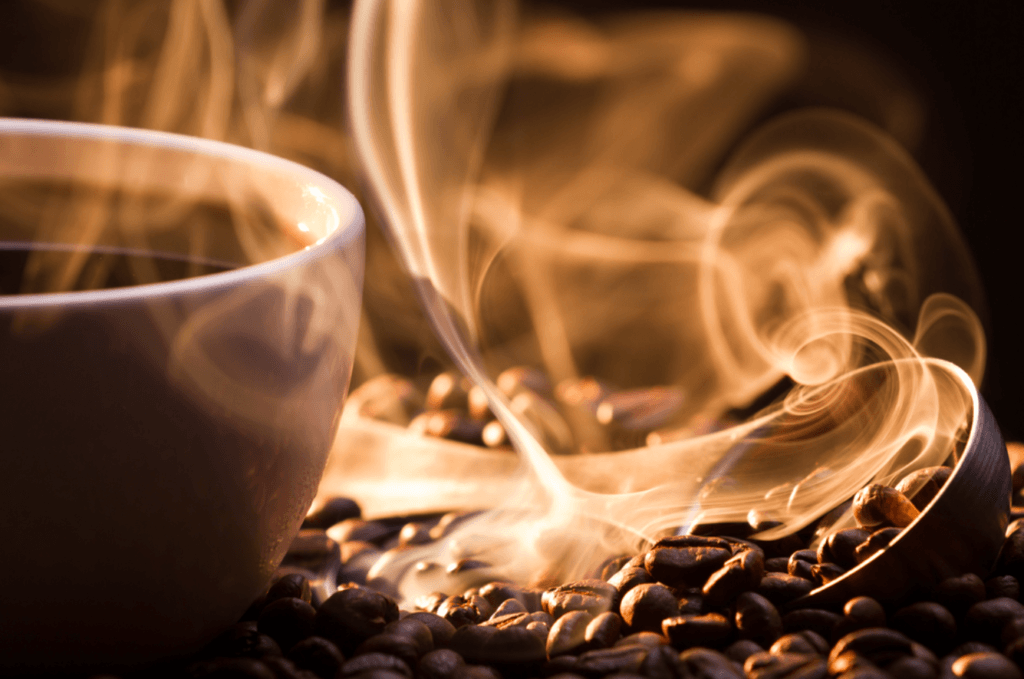Aroma Coffee
“Have you ever been enchanted by the captivating aroma of freshly made coffee? Every taste is followed by that heady, tempting aroma that promises to be both soothing and stimulating. It is more than simply a scent; it is a sensory experience that comes before the first bite.
In this blog, we explore the world of coffee fragrance and learn about the complex science and creativity that go into creating this sensual joy. Come us on this smell journey as we discover the mysteries behind coffee’s captivating aroma.
What is Coffee Aroma?

The scent of coffee is the essence of aroma. Many flavor characteristics, including sweet, salt, bitter, sour, and umami, that are not immediately sensed by the tongue are produced by it. Coffee has more than 800 recognized aromatic compounds, and because of improvements in testing technology, more are constantly being found.
Fresh coffee will have a lot greater aroma than older, stale coffee since aroma is the release of delicious components from coffee through the air. In general, the aroma is stronger as a roast goes darker because more coffee chemicals are altered and become perceptible. Some of the advantages of paying more for coffee are eliminated by the roasting process which especially when done to darker degrees removes the chemicals that give high-end coffee its distinctive characteristics.
How Coffee Aroma Casts Its Spell?
The flavor of the coffee can range from mild and delicious to burned, depending on how it has been roasted. The majority of coffee will smell almost nutty and gently caramelized. Old coffee will have a musty, cardboard-like smell. It can be difficult to describe a smell but coffee professionals have a trick up their sleeves. When deciding what adjectives to use to describe coffee they consult the Coffee Taster’s Flavor Wheel.
The most comprehensive and collaborative study on coffee flavor ever performed has given rise to a new set of terms for specialists in the field. To classify a coffee it divides dozens of flavors and scents into categories. For instance, milder roast scents are frequently described as fruity, floral, or herbal. Dark roasts feature strong scent descriptors like smoky and earthy whereas medium roasts can be caramelized, nutty, spicy, or chocolaty.
Explore: Where Does the Aroma of Coffee Come From?

To produce and release the volatile molecules our nose can perceive, you must roast coffee beans because unroasted coffee beans have no scent. The Maillard Reaction between sugar and amino acids is largely to blame for the flavor of coffee. The flavor of many browned foods is produced by this process, which takes place at high heat. Be aware that roasting doesn’t always result in pleasant scents. For instance, roasting too long results in the formation of phenols like guaiacol, which has an ashy smell.
By increasing the surface area of the coffee to release more fragrant chemicals, grinding coffee boosts its scent. Even more, scent is produced when coffee is brewed because various compounds are extracted by the hot water. Even more aromatic chemicals are present in coffee beans than in wine, at around 800. However, only about 30 of them can be detected by human senses. Just picture what your dog must think of your morning coffee.
Unraveling the Best -Taste Coffee
Freshly roasted coffee has the best aroma since roasting causes coffee to quickly lose flavor, which can be detected through scent. Less flavor means less fragrance. You must purchase coffee directly from a coffee roaster rather than from a store shelf if you want the best aroma. Coffee will stay as fresh as possible for as long as possible if you order it in a 1-way valve seal bag.
Order whole beans if you can, then ground them yourself. The decision to prefer a strong “coffee” fragrance over the intricacies of each origin is ultimately yours. Cheap Colombian or Brazilian coffee can have a fantastic aroma without being pricey.
Coffee Flavor and Aroma
Consider the fact that just five flavors may be detected by your tongue’s receptors: sweet, sour, salty, bitter, and umami, which is a Japanese term for the savory taste often found in cooked meat, to demonstrate the idea that scent is the most crucial aspect of taste. Now consider whether you feel like you have experienced more flavors in your life than just these five flavors alone.
With the power of fragrance, you probably feel as though there are many more flavors than just these five. We can smell a much wider variety of fragrances than we can taste because our nostrils have a much greater variety of receptors than our tongues. Many of the complex and delicious flavors that foodies, wine experts, and coffee lovers enjoy have their roots in smell.
Benefits of Using Fresh Coffee in Morning
Stale coffee doesn’t taste as good as fresh coffee. That’s really all there is to it, although fragrance determines the specifics. After being roasted, coffee beans begin to lose flavor over the course of about a month. Roasted coffee loses the majority of its scent after a month, and its flavor quickly degrades. Although green coffee can be stored for several months before going bad, most individuals are unable to roast their own coffee at home.
Purchase your coffee straight from a roaster if you want the freshest, best-smelling, and consequently best-tasting coffee available. The majority of specialty coffee roasters roast on demand, so your coffee won’t be roasted until you place your order. You must get your coffee directly from a roaster if you want the freshest, best-smelling, and ultimately best-tasting coffee available.
The majority of specialty coffee roasters produce coffee to order so your order won’t be fulfilled until the coffee has been roasted. This guarantees that your coffee will taste its best because it will have been roasted less than a week before it arrives. You can rely on the sniff test to point you toward the freshest coffee in your neighborhood store if purchasing directly from a roaster is not an option for you. Choosing the best-smelling coffee you can find will result in better tasting coffee.

How Drinking Coffe Helps Us to Remove Acidity?
The relationship between coffee aroma, taste, and acidity are unique. Coffee’s flavor and acidity are both influenced by its fragrance. For instance, if a coffee has a very rich flavor, its scent will similarly be rich, and if it has an acidic flavor, it will smell acidic.
The scent of a coffee conveys some of the more subdued flavor components (such as high, transient aromas) the best. Because the human senses frequently cooperate, the scent may also have a very modest impact on the flavor characteristics and taste perceptions of coffee.
Scent Symphony: How Terroir and Roast Profile Affect Coffee Aroma
Different types of carbohydrates, proteins, and acids are the precursors to scent. They change into volatile molecules throughout the roasting process, but especially during the Maillard reaction. During roasting, many components produce a variety of sensory characteristics, and the degree of roasting can further affect how we experience the aroma. Roasted notes are caused by 2-methylpyridine. Pyrazines, such 2,3-dimethylpyrazine, can produce a nuttiness or a burnt scent, like 2-Ethyl-3-methylpyrazine.
Sugars caramelize as the roast progresses to a more advanced stage. This results in the production of furans and furanones such the caramel-flavored 4-hydroxy-2,5-dimethyl-3(2H)-furanone. Volatile molecules that emit aromas are also produced by Strecker Degradation, which breaks down amino acids in aldehydes. Aromas produced by 3-methylbutanal are sweet and fruity.
How Coffee Aroma Boost Your Sipping Experience?
Coffee’s scent serves as the precursor to a sensory meet that goes beyond taste. It’s the first impression, the initial allure, that draws you towards that eagerly anticipated first sip. Coffee is no different in that our perception of flavor is greatly influenced by our olfactory senses. A symphony of volatile substances interacts with your senses as you breathe in the rich, nuanced scent of freshly brewed coffee. A multi-layered sensation that primes your palette for the upcoming indulgence is created when earthy notes blend with hints of nuttiness, floral undertones dance alongside delicate hints of fruitiness, and so on.
How Many Aromas are in Coffee?
There are 800 aromatic compounds present in the coffee. Coffee offers a sensory symphony that rivals even the most sophisticated scents, a treasure mine of fragrant richness. The complex tapestry of coffee scents is said to be woven together by over a thousand different volatile chemicals.
These substances are produced at various points along the coffee’s journey, from the development and cultivation of the plant to the roasting procedure and the final brewing. Each of these components adds a unique set of fragrant notes, creating a strikingly wide variety of smells.
These scents can be divided into three groups: primary, secondary, and tertiary. Primary smells, which provide distinct notes like flowery, fruity, or earthy, are closely related to the coffee’s variety, origin, and processing methods. When roasting, secondary fragrances such as nutty, chocolaty, or caramelized are produced when components undergo the Maillard reaction.
As the water interacts with the coffee grounds during the brewing process, secondary smells, such as bready or spicy flavors, are released. Together, these complex chemical interactions create the beautiful aromatic experience that comes with every cup of coffee.
Wrapping Up!
In this blog, we tell you everything about coffee aroma and its fragrance. We hopped that now you can easily choose your best aroma coffee. We suggested you to drink coffee like black ivory that is organicly prepared by elepehnant wastage. If you drink coffee like this so share your experience with us. We are love to listen your comments.

